The long road to Vostochny: Inside Russia’s newest launch facilityby Matthew Bodner — January 30, 2019
This article originally appeared in the Jan. 21, 2019 issue of
SpaceNews magazine.
 Russia has labored for years to bring its new Vostochny Cosmodrome online. In the early morning hours of Dec. 24, a key milestone was passed with the rollout of the spaceport's first semi-commercial launch. The launch went off perfectly Dec. 27, but many questions about the future of the launch facility — intended to replace the Baikonur Cosmodrome — linger amid economic turmoil and shifting priorities for the Russian space program. Credit: Matthew Bodner for SpaceNewsRussia has labored for years to bring its new Vostochny Cosmodrome online. In the early morning hours of Dec. 24, a key milestone was passed with the rollout of the spaceport's first semi-commercial launch. The launch went off perfectly Dec. 27, but many questions about the future of the launch facility — intended to replace the Baikonur Cosmodrome — linger amid economic turmoil and shifting priorities for the Russian space program. Credit: Matthew Bodner for SpaceNews
Russia has labored for years to bring its new Vostochny Cosmodrome online. In the early morning hours of Dec. 24, a key milestone was passed with the rollout of the spaceport's first semi-commercial launch. The launch went off perfectly Dec. 27, but many questions about the future of the launch facility — intended to replace the Baikonur Cosmodrome — linger amid economic turmoil and shifting priorities for the Russian space program. Credit: Matthew Bodner for SpaceNewsRussia has labored for years to bring its new Vostochny Cosmodrome online. In the early morning hours of Dec. 24, a key milestone was passed with the rollout of the spaceport's first semi-commercial launch. The launch went off perfectly Dec. 27, but many questions about the future of the launch facility — intended to replace the Baikonur Cosmodrome — linger amid economic turmoil and shifting priorities for the Russian space program. Credit: Matthew Bodner for SpaceNews
The construction of Russia’s newest space launch facility, the Vostochny Cosmodrome, was inevitable from the moment the Soviet Union dissolved in 1991.
After leading the charge into space, post-Soviet Russia found itself suddenly without a major spaceport on its territory. Newly independent Kazakhstan became the owner of the Baikonur Cosmodrome, and Russia has been forced to lease the facility ever since. But access to the launch facility depends on political relations with Kazakhstan — and in recent years, environmental activists have protested Baikonur’s use.
In other words: were it not for the collapse of the Soviet Union, it is not likely Russia would have ever built Vostochny. Baikonur continues to be the primary hub for Russian space activities, and it is further south — making it a better launch site for most space missions. Economic problems in Russia and shifting priorities for the Russian space program have slowed the pace of Russia’s shift from Baikonur to Vostochny. It is in some ways a cosmodrome without a mission.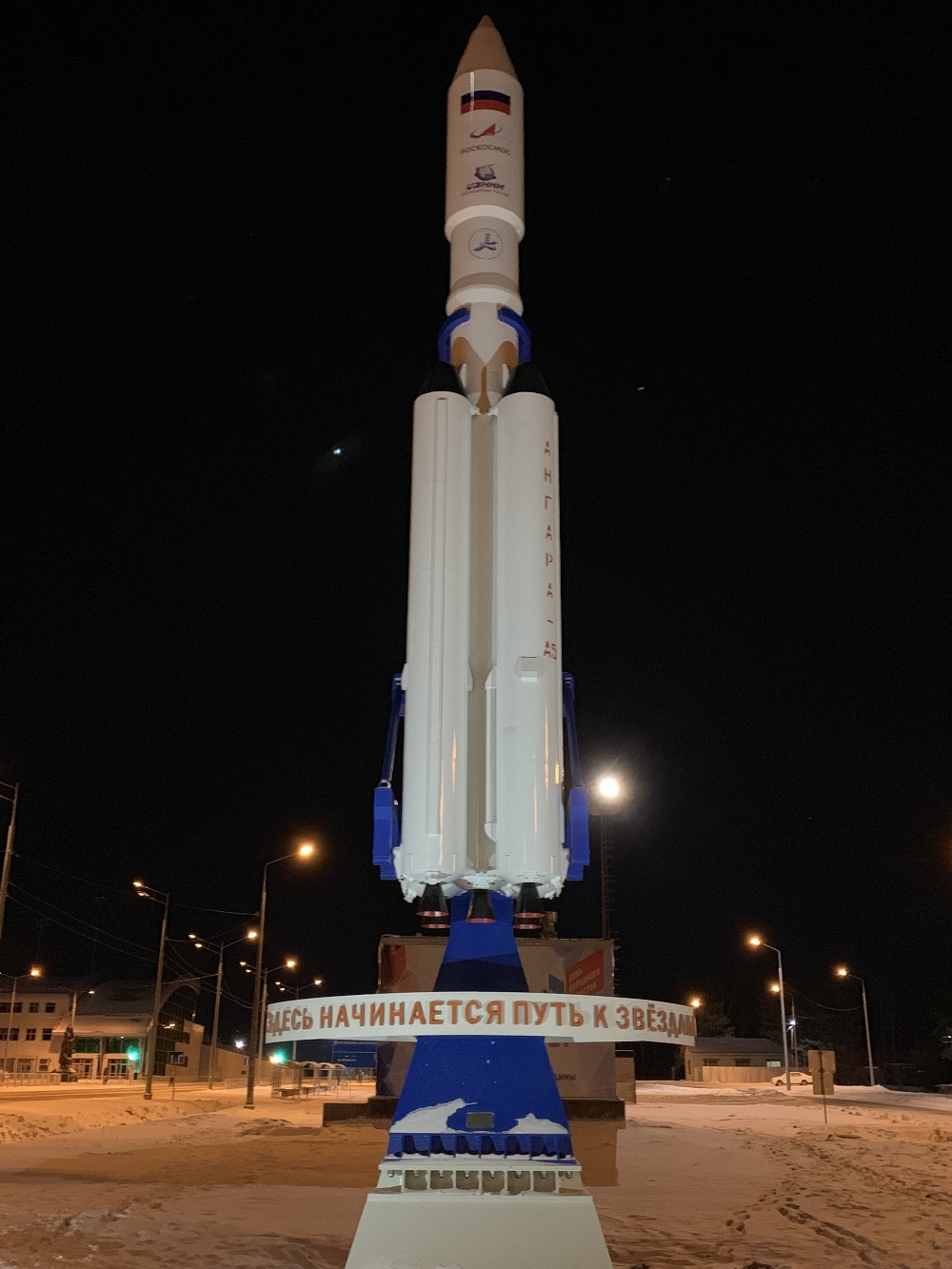 A monument to Russia’s new Angara A5 rocket stands at the entrance to Vostochny. A sign below reads “Here begins the path to the stars.” Credit: Matthew Bodner for SpaceNewsBut Russia has pressed forward with the project, largely for political reasons. Aside from Russia’s $4 billion bridge connecting mainland Russia to the Crimean Peninsula that Moscow annexed from Ukraine in 2014, President Vladimir Putin has not presided over a larger, more politically and economically significant infrastructure project than the 150 billion-ruble ($2.24 billion) space launch facility.
A monument to Russia’s new Angara A5 rocket stands at the entrance to Vostochny. A sign below reads “Here begins the path to the stars.” Credit: Matthew Bodner for SpaceNewsBut Russia has pressed forward with the project, largely for political reasons. Aside from Russia’s $4 billion bridge connecting mainland Russia to the Crimean Peninsula that Moscow annexed from Ukraine in 2014, President Vladimir Putin has not presided over a larger, more politically and economically significant infrastructure project than the 150 billion-ruble ($2.24 billion) space launch facility.
The Russian space agency, Roscosmos, has been touchy about the Vostochny Cosmodrome in recent years. Meant to be a powerful totem of Russian modernization under Putin’s regime, Vostochny has instead been mired by failure, construction mishaps and delays. Cost overruns and millions of dollars lost to an endless stream of corruption scandals have brought unprecedented scrutiny down upon Roscosmos.
Since construction began in 2007, the facility has been closed to Western journalists. But Dec. 24 — Christmas Eve — Roscosmos granted SpaceNews access to the cosmodrome as part of a revealing, though highly restricted and tightly controlled press tour. The tour was organized and managed by GK Launch Services, a new Roscosmos subsidiary created to sell and operate commercial launches of Soyuz-2 rockets from the Vostochny Cosmodrome and other Russian launch sites.
Contact with cosmodrome personnel was also heavily choreographed. And upon a second visit to the facility to witness the fourth launch of a Soyuz-2 rocket from Vostochny Dec. 27, a SpaceNews reporter was tailed by the most obvious minder outside of Pyongyang. It was not clear if the man was simply a patriotic local alarmed by the presence of an American reporter, or a regional security services official justifying a paycheck.
Despite these restrictions on reporting efforts, Vostochny appeared to be a functioning, effectively managed space launch facility. And its construction has brought life to one of Russia’s most remote and underdeveloped regions, Amur Oblast, injecting residents with pride and hope for exciting economic opportunities as Moscow works to turn the region into Russia’s space science and industrial hub.
“The path to the stars begins here,” reads a plaque just outside the entrance to the Cosmodrome, perched below a monument to Russia’s new Angara rocketA Cosmodrome in Search of a Mission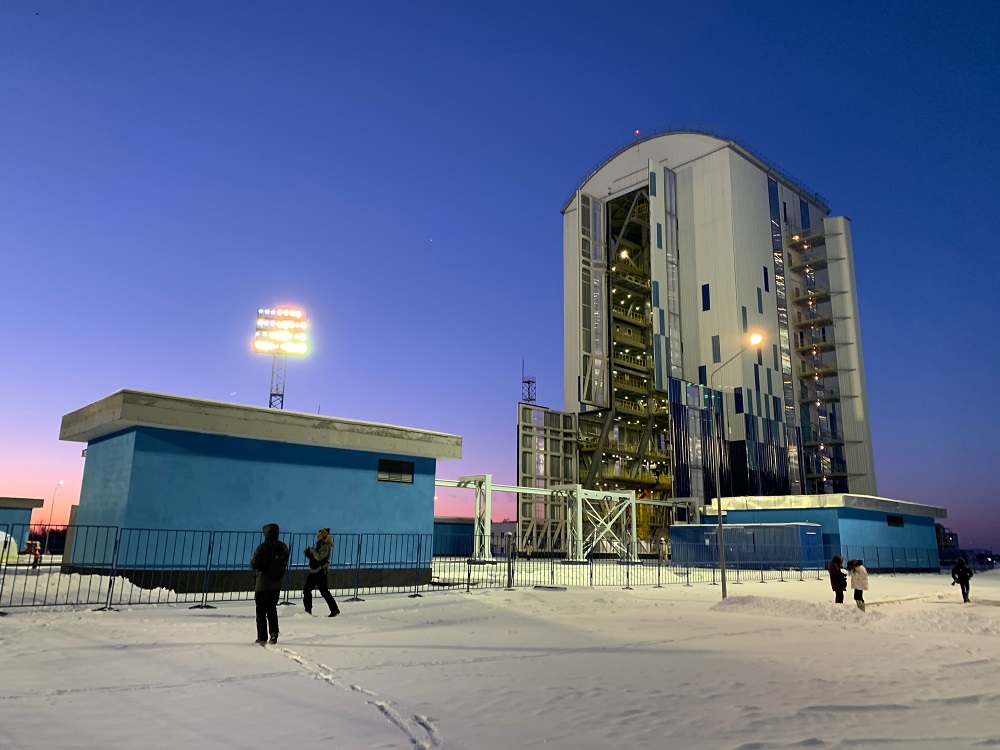 The key feature that distinguishes Vostochny’s Soyuz launch complex from the older Soyuz facilities at Baikonur is a mobile service tower. Credit: Matthew Bodner for SpaceNewsVostochny isn’t an easy location to reach. Like most space launch facilities across the globe, two primary factors determined where the site was laid: proximity to the equator and distance from population centers. The facility was also once home to an intercontinental ballistic missile base, which provided some basic infrastructure useful for a cosmodrome — such as existing links to major railways. But it is still a facility in search of a mission.
The key feature that distinguishes Vostochny’s Soyuz launch complex from the older Soyuz facilities at Baikonur is a mobile service tower. Credit: Matthew Bodner for SpaceNewsVostochny isn’t an easy location to reach. Like most space launch facilities across the globe, two primary factors determined where the site was laid: proximity to the equator and distance from population centers. The facility was also once home to an intercontinental ballistic missile base, which provided some basic infrastructure useful for a cosmodrome — such as existing links to major railways. But it is still a facility in search of a mission.
Though it covers some 700 square kilometers of Russian taiga, most of the facility remains unused real estate. Vostochny currently only has launch facilities for the Soyuz-2 rocket, and progress on pads for what was once promoted as the future of the Russian space program — the Angara family of rockets — has been slow going. Construction is reportedly underway, but completion is not slated till sometime in the mid-2020s.
The future of Angara itself at times seems in doubt. Though it has flown two successful test flights, serial production of Angara has also been kicked into the 2020s. Meanwhile, Russian space officials have turned to a new project as a beacon of hope for Russia’s future in space, the Soyuz-5. This new rocket, which is still in development, has usurped Angara as the flag bearer of Russia’s manned space program in the future.
But the Soyuz-2 launch complex is operational, and will be the heart of Vostochny for some time. And these facilities are significantly more modern than those seen at Baikonur, reflecting Russia’s extensive experience in designing cosmodromes. Much of the complex is an evolution of the facility Russia built at the ESA spaceport in French Guiana. Operational know-how from Baikonur melds with design experience from French Guiana at Vostochny.
The entire process of assembling and launching a rocket at Vostochny is highly streamlined. Launch vehicles are delivered in pieces by rail from Samara on the other side of the country directly into the vehicle assembly building. Upper stages and payloads are transported by air. The launch vehicle is assembled by 50-ton cranes on one side of the facility, while the upper stage and payloads are prepared on the other side. The process of rolling a Soyuz rocket out from the assembly building to the launch pad takes about an hour, final checks take about two days. Credit: Matthew Bodner for SpaceNewsFrom there, the upper stage and payload are moved, via a tunnel connecting the two sides, to the other building — where the Soyuz launch vehicle is assembled and mated with the upper stage. This side of the vehicle assembly complex is massive, measuring 90 meters long and 48 meters wide. Its height appeared to be about 48 meters as well. It is a massive space and it takes a moment to find your bearings and locate a 52-meter Soyuz rocket upon entering the bright assembly hall.
The process of rolling a Soyuz rocket out from the assembly building to the launch pad takes about an hour, final checks take about two days. Credit: Matthew Bodner for SpaceNewsFrom there, the upper stage and payload are moved, via a tunnel connecting the two sides, to the other building — where the Soyuz launch vehicle is assembled and mated with the upper stage. This side of the vehicle assembly complex is massive, measuring 90 meters long and 48 meters wide. Its height appeared to be about 48 meters as well. It is a massive space and it takes a moment to find your bearings and locate a 52-meter Soyuz rocket upon entering the bright assembly hall.
Cameras, perhaps the same ones installed by Roscosmos Director-General Dmitry Rogozin so he could search for “slackers” from his office in Moscow, line the walls of the assembly hall.
About 1,800 people work each shift at the vehicle assembly building, said Alexei Gulyaev — the deputy director of Vostochny operations for Soyuz manufacturer TsSKB-Progress. About 5 kilometers away, an additional 200 people staff the launch pad. To support a launch, Gulyaev says about 1,000 personnel are flown in from Russia’s primary launch facility, the Soviet-built Baikonur Cosmodrome in Kazakhstan — the world’s busiest launch site.
The experience the Baikonur staff bring to Vostochny shows when the Soyuz rocket is rolled out to the launch pad, and then quickly lifted onto the stand. During the Apollo and Space Shuttle programs, NASA took days to move their vehicles from the assembly building to the pad. Roscosmos does this in about an hour or two. Much of the process happens the same way it does at Baikonur, Gulyaev explained at a briefing in Blagoveshchensk.
The rollout begins with a steady procession of uniformed parkas past a cordon that cuts the room in two. They all assemble in a neat formation down the hall next to the Soyuz rocket as the massive hangar-bay doors crawl open and a Roscosmos-branded diesel engine powers up. In a final act of ceremony, the vaunted State Commission stands before the crowd and gives a final sign off that the rocket can be delivered, by rail, to the pad.
About a dozen personnel walk alongside the rocket as it makes its way to the launch complex. A fire truck and several minivans and SUVs drive alongside.
Though much of the process is modeled on Russia’s 60 years of experience in operating the Baikonur Cosmodrome, the launch complex is where this process begins to differ. The launch pad does not have a built-in, claw-like gantry like the one seen at Baikonur. Rather, after being hoisted on the pad, the rocket is serviced by a 1,600-ton mobile service tower that is rolled out over the pad and the rocket and sealed to protect the vehicle.The long road to Vostochny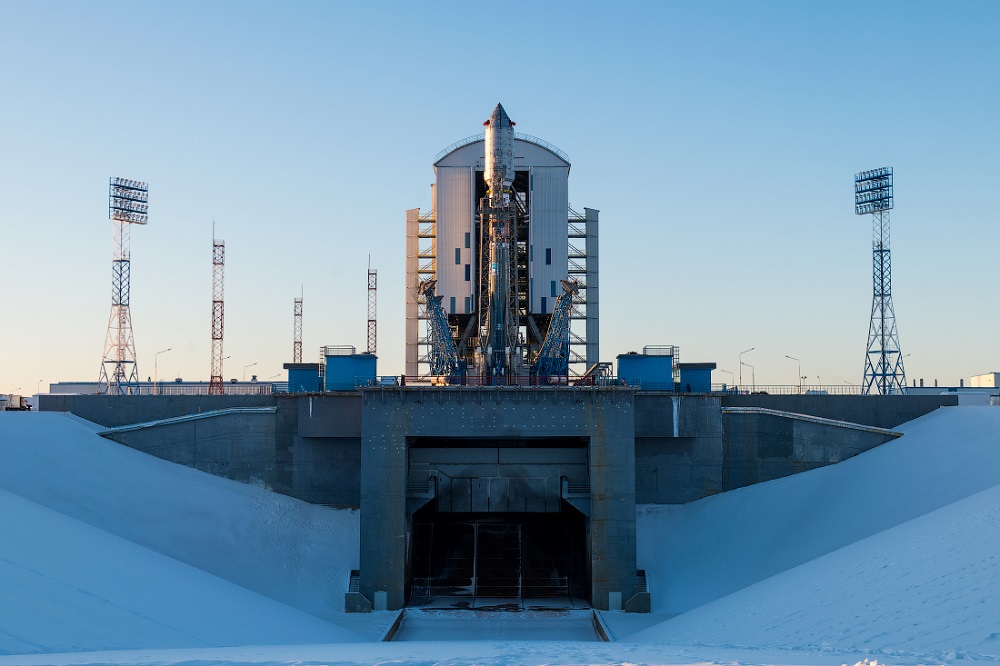 After the Soyuz is propped up onto the pad, the mobile service tower is moved into position over the rocket, giving engineers easy access for pre-launch checks. Credit: GK Launch ServicesBad press doesn’t even begin to describe the treatment Vostochny has received from independent Russian media. A 2015 investigation by news outlet RBC that delved into how Vostochny became “the most expensive spaceport in the world” detailed how the project was “chaotic and haphazard from the start.” The project has churned through three Roscosmos directors, several project bosses, and scores of middle managers.
After the Soyuz is propped up onto the pad, the mobile service tower is moved into position over the rocket, giving engineers easy access for pre-launch checks. Credit: GK Launch ServicesBad press doesn’t even begin to describe the treatment Vostochny has received from independent Russian media. A 2015 investigation by news outlet RBC that delved into how Vostochny became “the most expensive spaceport in the world” detailed how the project was “chaotic and haphazard from the start.” The project has churned through three Roscosmos directors, several project bosses, and scores of middle managers.
Over 150 billion rubles had been spent on the project since it began in 2007. Russia’s Prosecutor General Office said in December that since 2014, 10 billion rubles have been stolen or lost, 17,000 legal violations have been documented, 140 criminal cases have been opened, and 50 people sentenced under those investigations. Twenty-seven were convicted in 2018, a spokesman for the prosecutor general told a Russian internet news outlet Dec. 20.
In perhaps the most outrageous act of corruption at Vostochny, a senior construction manager fled the site with 4 million rubles in advance payment for work his company never even began. Local police put him on the international wanted list, local media reported, which allowed authorities in neighboring Belarus to chase the suspect down in Minsk while driving a nondescript Mercedes sedan studded in $300,000 worth of Swarovski diamonds.
These scandals persist to this day. In early January, the head of a telecoms contractor working at the cosmodrome was arrested at Moscow’s Sheremetyevo airport as he attempted to fly to Vietnam. The contractor is accused of pilfering nearly 26 million rubles ($387,000) from the project. But lost in the constant drum of scandal and corruption coming out of Vostochny is the social and economic impact of the project on one of Russia’s most isolated and underdeveloped regions.
In Moscow, officials from Putin on down have, multiple times, warned that the Vostochny project is critical for national security and would face tighter scrutiny than most Russian construction projects. In the capital, the project is typically discussed in the context of scandal and is the often the butt of jokes. But in Amur Oblast, the project has injected life and hope for economic opportunity into one of Russia’s most isolated and underdeveloped regions.
In Tsiolkovsky — an old military town that housed families of staff the local intercontinental missile base upon which Vostochny was built — the rundown LEGO-like apartment buildings are being rapidly renovated with modern interiors to make way for engineers and scientists who are increasingly calling the town home as Vostochny operations come online and expand. The town doesn’t have much to offer besides a space museum and some cafés.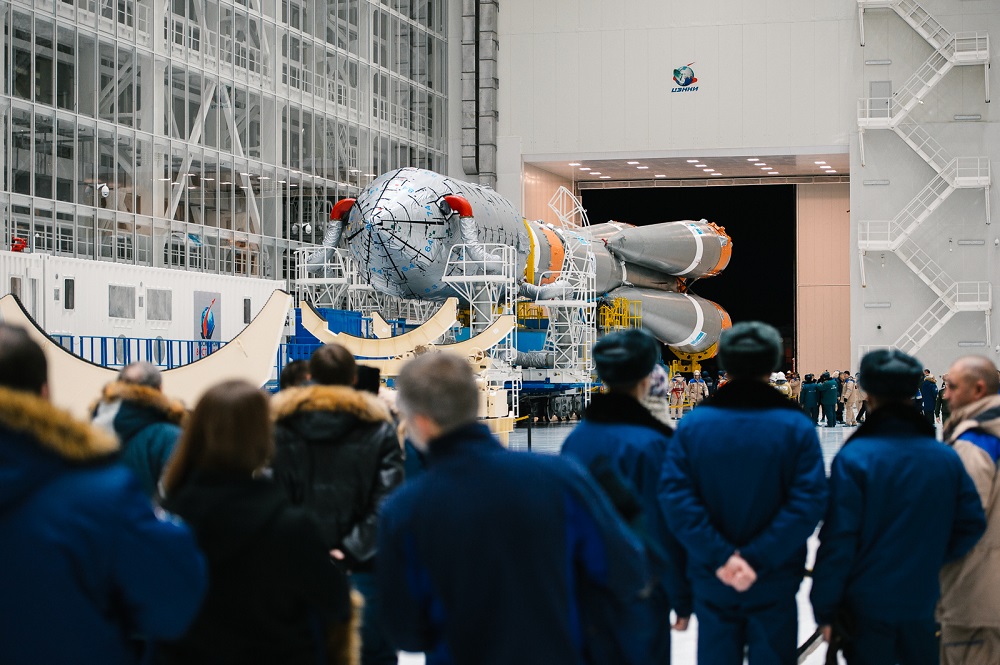 Over 1,000 personnel from Baikonur are flown into Vostochny to support a Soyuz launch. Much of the processes resemble those seen at Baikonur. Credit: GK Launch ServicesA tour guide, during a rushed, yet well-rehearsed tour of the museum, waxed lyrical about the impact of the cosmodrome on life in her town. And she knew exactly who to thank: Putin. In fact, the local museum has an entire display dedicated to Putin and his work on the Cosmodrome. Rogozin has a similar shrine devoted to him. When approached later for follow up on these points, the guide denied ever meeting a SpaceNews journalist.
Over 1,000 personnel from Baikonur are flown into Vostochny to support a Soyuz launch. Much of the processes resemble those seen at Baikonur. Credit: GK Launch ServicesA tour guide, during a rushed, yet well-rehearsed tour of the museum, waxed lyrical about the impact of the cosmodrome on life in her town. And she knew exactly who to thank: Putin. In fact, the local museum has an entire display dedicated to Putin and his work on the Cosmodrome. Rogozin has a similar shrine devoted to him. When approached later for follow up on these points, the guide denied ever meeting a SpaceNews journalist.
There isn’t much to do in Tsiolkovsky. Residents tend to pass time with hobbies such as hunting, fishing, or — in the case of TsSKB’s Gulyaev — building models. “There are no difficulties with buying model sets in Tsiolkovsky. They are expediently delivered by mail.” The town has no movie theater, but it has a few cafés, he said.
Despite all the talk of openness, and the clearly monumental efforts made by those elements of the Russian space industry interested in attracting foreign business, a very Soviet-style paranoia hangs over the cosmodrome and its people. Even in compromise, the latter mentality holds its ground.
But the situation is less extreme back in the regional capital Blagoveshchensk, where the pull of Vostochny is also beginning to make itself felt. Though nearly every local approached by SpaceNews for this story declined to comment, it was clear from informal conversation that the project has become the sole source of hope for better work and economic opportunity in the region.
Blagoveshchensk has been one of the key beneficiaries of the project. Planted firmly on the Amur River in the Far East, Blagoveshchensk has historically served as little more than a statement to Beijing that Moscow’s sovereignty begins on the river’s northern banks. But it is an increasingly obsolete point in the modern age, as China’s influence weighs heavily on this Russian outpost 8,000 kilometers away from Moscow.
Blagoveshchensk isn’t a large or particularly well-off city. It boasts a population of some 200,000 people and, in many ways, still resembles the Russia of the 1990s — dilapidated and in search of purpose. And where there’s money, it is coming from across the river. Standing on the northern bank of the frozen Amur, Russians can see the Chinese city of Heihe spreading wide along the frontier, enticing them with modern high-rises and bright, flashing neon signs.
But in recent years, the Vostochny Cosmodrome has risen as a new star to guide residents of Blagoveshchensk. At a local history museum, centuries of frontier politics with China have been bumped aside by a new identity: Russia’s space city. The opening display of the museum is dominated by Putin and his cosmodrome project. A meteorite fragment, which fell upon Amur Oblast long ago, is displayed as well as if to provide another anchor to the cosmos.
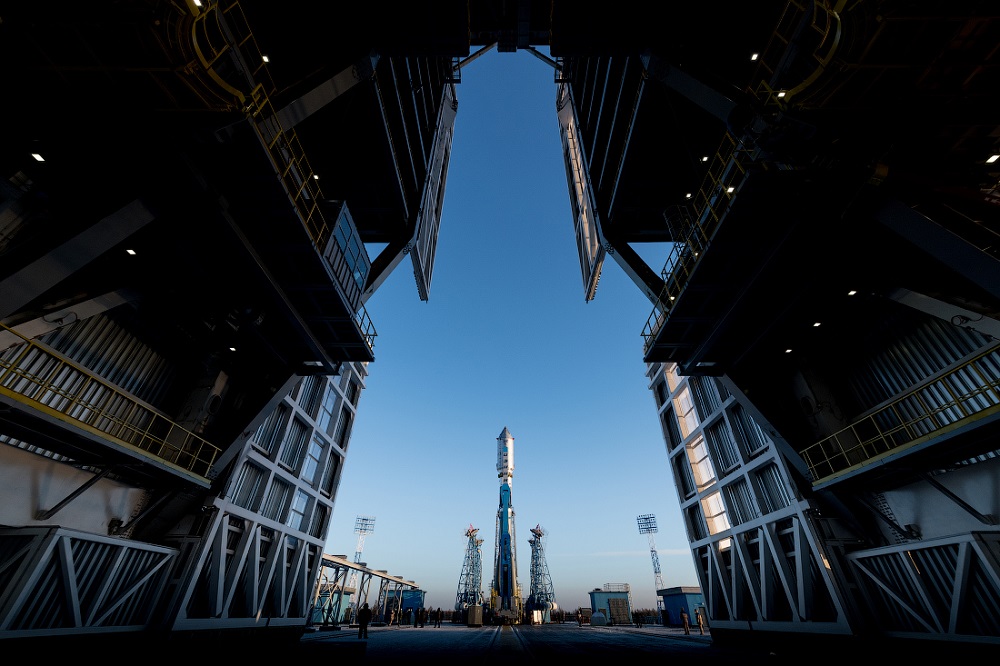
Only four launches of Soyuz have taken off from Vostochny, and the pace of transitioning from Baikonur to the new Cosmodrome has been slow. The project has churned through three Roscosmos directors, several project bosses, and scores of middle managers. Credit: GK Launch Services
Nowhere is this new identify felt more than at Amur State University. As part of the Vostochny project, authorities in Moscow have been pouring resources into Amur State University to create a new space faculty that is already beginning to push students through training programs and work apprenticeships to develop Russia’s next-generation cosmodrome cadres. And here a fusion of the region’s China-facing frontier meshes with its newer, loftier aspirations.
Across the space faculty and university at large, signs are written in Russian and in Chinese. Exchange students from across the river flock here in droves, and students participate in countless scientific and engineering projects with Chinese students. It is a very clear reflection of growing talk among Russian leadership that the country’s future in space does not lay in cooperation with NASA and the West, but with the ascendant Chinese space program.
Indeed, in the halls of Amur State University, the rich history of U.S.-Russia space rivalry and cooperation has already been relegated to the various rooms set aside as little space history museums. Something for students to ponder and reflect upon as they go about planning presentations for their next student scientific congress with their Chinese peers. Caught between the pull of Vostochny and China, these students have discovered hope for a future of opportunity in space.
Ilya Oleinik, a student at the university from Blagoveshchensk, told SpaceNews he believes this future is the key to humanity’s survival and that the cosmodrome — and education programs at Amur State University — have given him a chance to be part of that future. He hopes to build satellites, and showed off a project he hopes to complete in 2021.
“Amur has become a more active region,” Oleinik said, “before the construction of the cosmodrome, nothing was really happening here. Now there is more attention being paid to the region, it is being more actively developed.”Source:
https://spacenews.com/the-long-road-to-vostochny-inside-russias-newest-launch-facility/